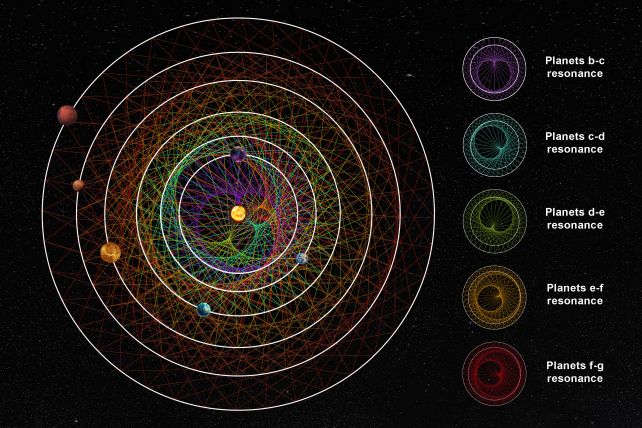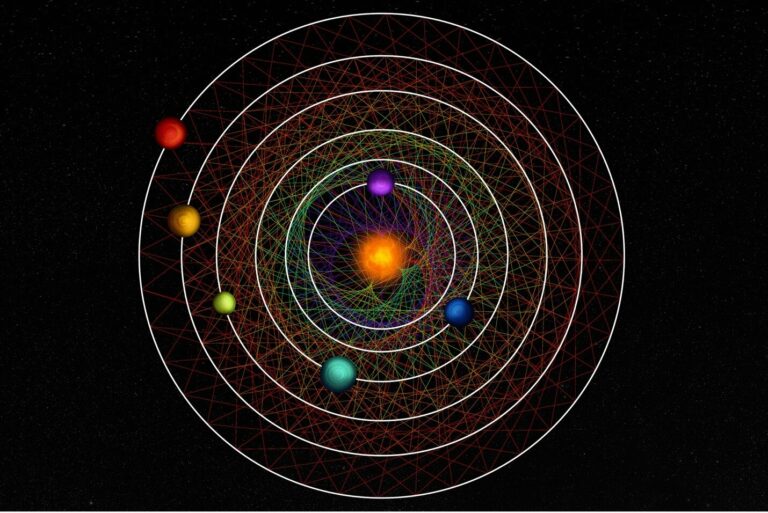Researchers Uncover Six Extraterrestrial Worlds in Flawless Synchronization
In the vicinity of the Solar System lies a planetary system boasting six celestial bodies gracefully encircling their star in perfect synchronicity.
The bright star HD 110067 is at the center of this extraordinary display, as each of the six exoplanets in its orbit demonstrates a remarkable alignment, forming a captivating chain of resonance. This rare phenomenon hints at the system’s undisturbed existence since its formation over a billion years ago, presenting itself as a unique and well-preserved celestial gem within the vast expanse of the Milky Way.
Astrophysicist Rafael Luque from the University of Chicago notes, “We estimate that only about one percent of all systems maintain such resonance, revealing to us the pristine configuration of a planetary system that has endured the test of time, remaining largely untouched.”
Orbital resonances are not only common but also anticipated occurrences in celestial mechanics. These resonances manifest when two celestial bodies, both orbiting a third celestial body, mutually influence each other gravitationally, aligning their orbital periods. While exact 1:1 resonances are considered rare, these relationships are often expressed as ratios.
For instance, a well-known example is the resonance between Pluto and Neptune, with Pluto completing two orbits around the Sun for every three orbits of Neptune, forming a 2:3 resonance. Similarly, certain moons of Jupiter are part of a resonance chain; Ganymede, Europa, and Io exhibit a 1:2:4 chain, also recognized as a Laplace resonance.
However, the observation of six exoplanets forming a resonance chain is an exceptionally rare phenomenon.
This remarkable discovery occurred around an orange dwarf star situated approximately 100 light-years away in the northern constellation of Coma Berenices. NASA’s TESS exoplanet-hunting telescope identified indications of two orbiting planets in 2020. While one planet displayed an orbital period of 5.642 days, the orbital period of the other remained undisclosed.

Upon TESS’s return to the system after a two-year interval, the collected data remained perplexing. In an effort to gain a clearer understanding, astrophysicist Rafael Luque and his team leveraged the European Space Agency’s Cheops exoplanet-studying space telescope for a more detailed examination. This closer scrutiny revealed an error in the initially determined orbital period and unveiled the presence of not just two but three exoplanets, forming an intricate resonance chain.
The subsequent revelations fell into place seamlessly. Luque emphasizes the pivotal role of Cheops in unraveling the celestial mystery, stating, “Cheops gave us this resonant configuration that allowed us to predict all the other periods. Without that detection from Cheops, it would have been impossible.”
In total, the system hosts six exoplanets falling within the category of mini-Neptunes, exhibiting radii ranging from 1.94 to 2.85 times that of Earth. Their orbital periods, from the innermost to the outermost, are 9.11 days, 13.67 days, 20.52 days, 30.79 days, 41.06 days, and 54.77 days. Remarkably, these exoplanet pairs are in resonances of 3:2, 3:2, 3:2, 4:3, and 4:3, with the innermost world completing six orbits for every one orbit of the outermost. This configuration marks the system as only the third known instance featuring six exoplanets arranged in a chain of resonance.
Believed to have originated over a billion years ago, the star’s planets displaying such exquisite harmony implies an undisturbed history unaffected by external influences like planetary migration, significant impacts, or the gravitational pull of passing stars—a contrast to certain planets in our Solar System suspected of undergoing past migration.
Maintaining resonance is a delicate equilibrium, with many systems exhibiting orbital periods proximate to resonance but genuine resonance chains being exceedingly rare. The HD 110067 system stands as a rare and invaluable celestial find, providing astronomers with an exceptional opportunity to delve deeper into the intricacies of this captivating phenomenon.
The researchers emphasize the significance of this discovery, stating in their paper, “The current delicate configuration of the planetary orbits in HD 110067 rules out any violent event over the billion-year history of the system, making it a rare ‘fossil’ to study migration mechanisms and the properties of its protoplanetary disk in a pristine environment.”
With its host star’s brightness and the presence of extended atmospheres in most of its planets, HD 110067 emerges as the most promising multiplanetary sub-Neptune system for transmission spectroscopy observations using the James Webb Space Telescope. This unique system provides a golden opportunity to unravel the nature of sub-Neptune planets and gain insights into the dynamics of resonant chains—how, where, and under what conditions they form and endure.
The research has been published in Nature.
This article is republished from ScienceAlert under a Creative Commons license. Read the original article.
Do not forget to share your opinion with us to provide you with the best posts !




0 Comments